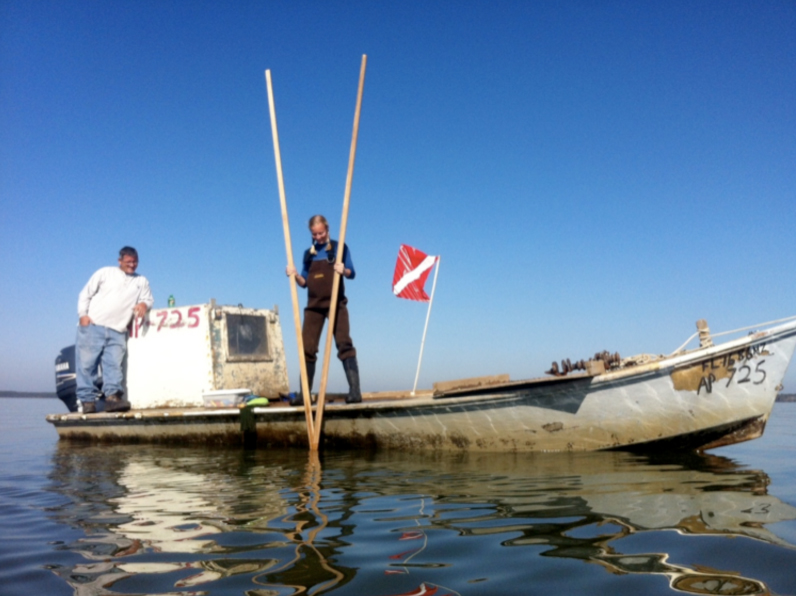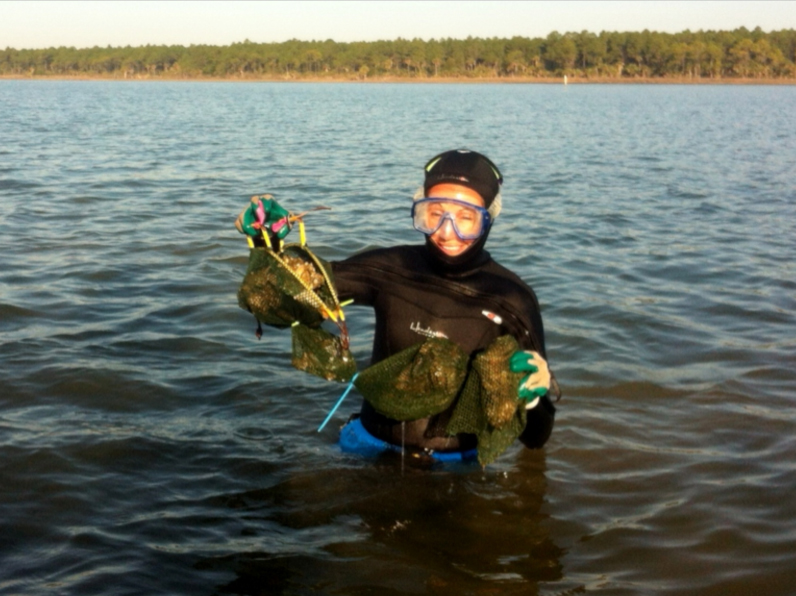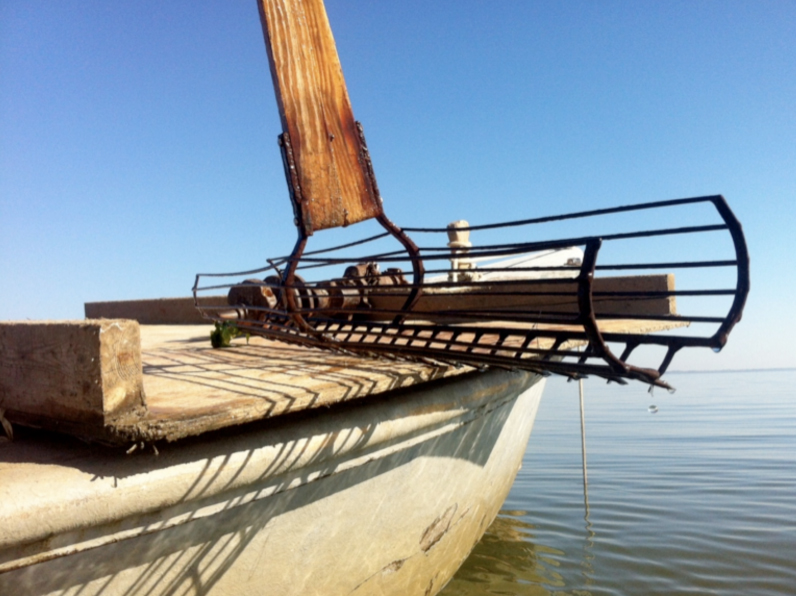Stephanie Buhler is the newest addition to the Hug-Bro family (the HUGhes and KimBRO labs). She and Hanna Garland have been alternating Scuba diving duties for David Kimbro’s new Apalachicola Bay study. Stephanie was nice enough to let us strap a GoPro camera to her head as she dove, allowing us to capture images of the floor of the bay. The images give an indication as to the severity of the fishery crisis. We will continue following this study. Tomorrow, we begin a series of videos looking at David and Randall Hughes’ NSF funded oyster study. Over the course of that research, they honed many of the techniques they’re using in Apalachicola Bay. The videos will take you into that study, and into the lives of oysters and the animals that make use of the reef.
This post was written on Sunday, January 20, 2013.
Stephanie Buhler FSU Coastal & Marine Lab
 Today marks our sixth day out in the Apalachicola Bay surveying the oyster reefs. It could not have been a more beautiful Sunday with the sun shining bright and a crisp-cool breeze as we drove to our first reef. While Hanna and I definitely have our methods down to a routine at this point, today we had the opportunity to learn a “new” technique for grabbing oysters that did not require a single regulator. This morning our boat captain, Shawn Hartsfield, brought his oyster tongs on the boat for us, and we had a blast trying to get his method down for picking up the oysters. Comically, he did not inform us that the metal tongs alone were about 40 lbs. as he watched our attempts in bringing our bundle of oysters to the bow of the boat. Best back and arm work out I have ever had!
Today marks our sixth day out in the Apalachicola Bay surveying the oyster reefs. It could not have been a more beautiful Sunday with the sun shining bright and a crisp-cool breeze as we drove to our first reef. While Hanna and I definitely have our methods down to a routine at this point, today we had the opportunity to learn a “new” technique for grabbing oysters that did not require a single regulator. This morning our boat captain, Shawn Hartsfield, brought his oyster tongs on the boat for us, and we had a blast trying to get his method down for picking up the oysters. Comically, he did not inform us that the metal tongs alone were about 40 lbs. as he watched our attempts in bringing our bundle of oysters to the bow of the boat. Best back and arm work out I have ever had!
Bringing the tongs onboard could not have happened on a more relaxed day. Typically Hanna and I alternate days being the boat tender/diver, but today all of our reefs were extremely shallow and no dive equipment or assistance was needed. A fantastic hassle-free Sunday of work.
The Apalachicola Bay study is funded by Florida Sea Grant. In the Grass, On the Reef is Funded by the National Science Foundation.



10 comments
[…] Donate Skip to content HomeThe ScienceThe “In the Grass, On the Reef” Master PlanCoastal Habitat Quick DictionarySalt MarshIn the Grass- Salt Marsh Biodiversity StudyMeet the Species “In the Grass”Oyster ReefOn the Reef- The Biogeographic Oyster StudyMeet the Species “On (and swimming around) the Reef”Watch Oysters GrowJacksonvilleSaint AugustineAlligator HarborSeagrass BedPredatory Snails, and Prey, of Bay Mouth BarIn the Grass, On the Reef DocumentaryEcoAdventures North FloridaEcoAdventures HomeActivitiesPaddlingHikingBird/ Wildlife WatchingArt/ PhotographyHistory/ ArcheologyApalachicola River and Bay Basin ← Notes From the Field: Becoming an Oyster Woman […]
[…] Last week, Dr. David Kimbro broke nutrients and oysters down for us. But what if oysters are too scared to eat the nutrient fed plankton they need to survive? David and Randall take us another step closer to understanding the Ecology of Fear, examining oysters’ choices and how their behavior affects the important habitat they create. Stay tuned over the following weeks as they unravel the relationships between predators and prey on oyster reefs and their neighboring coastal ecosystems. We’ll also continue to follow David’s crew in Apalachicola, Hanna and Stephanie, as they research the oyster fishery crisis. […]
I vacation in East Point regularly at my best friends house on bay north of the East Point-Apalachicola Bridge. HE has stated that the oystermen (and women) were allowed to harvest all they could take shortly after the recent Gulf oil spill. Essentially over harvesting oysters to the point of an extinction event. I wonder if this has been researched by you all?
HE & you that is not factual and unfair bias opinions or assumption. That is completely incorrect information and untrue. Check with the FCSWA, the Franklin Co. Commissioners and the Franklin County Extension Office regarding that issue.
Hi,
Honestly, we do not have concrete answers for what happened to get the oyster reefs into their current condition. But we are designing and implementing a monitoring program and some experiments that will allow us to answer such questions in the future.
Thanks for your questions.
best,
david
[…] & co. perfected during their NSF funded oyster study and which David will soon take to his Apalachicola Bay study. Stay […]
[…] other Florida reefs, including those at the edges Apalachicola Bay. In reviewing his crew’s initial sampling of the bay, he sees that the more heavily harvested subtidal reefs are being assaulted by a […]
[…] what David Kimbro and Hanna Garland have been working on. They have already completed their survey of the bay and presented a snapshot of predator distribution, reef structure, oyster size, and of oyster […]
[…] January, we conducted habitat surveys in order to assess the condition of oyster reefs throughout Apalachicola Bay by quantifying the […]
[…] January, David Kimbro’s lab did a preliminary survey of Apalachicola Bay oyster reefs, looking at the overall health of oysters and the presence of predators. They followed […]
Comments are closed.